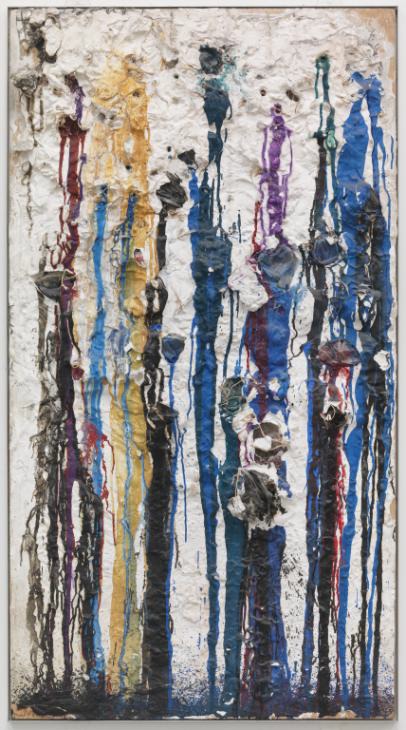Art and Performance
In this exhibit we will be discussing the use of performance to create art whether that be in film, in front of a live audience, or pre-exhibition behind the canvas. With the three pieces on display the way artists use performance will be considered. In Carolee Schneemann’s live performance she uses her body as an instrument to get across her message of equality in the world of art and film. In Isaac Julien’s Looking for Langston, the typical acting performance is used to tell the story of queer black men of the Harlem Renaissance. Julien’s use of mixed footage and black and white imagery show the illustrious world he dreamed of for these men. And with Niki de Saint Phalle’s performance of shooting a gun to create the spectacular paint drips and textured materials, we understand the deeper implications of how performance of a piece has a lot to say.
In this piece by Carolee Schneemann the performance is done in front of a live audience. The picture on display comes from one of the performances. The picture and the words along the margin are distressed with coffee, beet juice, and urine to make it appear as if it had been through a lot. The audience consisted of mostly women artists and happened in a few different art exhibits. Schneemann would come and stand on a pedestal and undress and then drape a sheet over her. She told the audience that she would read from a book titled, Cezanne, She Was a Great Painter and eventually remove the sheet and was left in an apron. Once completed with the excerpts from the book and removing the apron, Schneemann began to pull a scroll from her vagina and read from it. Upon the scroll was an excerpt from the film Kitch’s Last Meal, a documentary by Schneemann. Schneemann tends to look at the human body as completely sexual, however she uses the body and its sexuality to emblazon her feminist message and female form. The performance is to show the beauty and meaning of the vagina as a source of knowledge and truth. The vagina in the performance serves as a vehicle for a message on the treatment of women and how they aren’t viewed as equals, specifically in the world of filmmaking and art.
This video titled Looking for Langston was written and directed by British filmmaker, Isaac Julien, in 1989. The title of the film comes from Langston Hughes, who rose to notoriety during the 1960s. He was famous for combining jazz and poetry and leading the Harlem Renaissance, as well as serving as an activist for civil rights and a voice for black creatives. Despite the name of the film, this is not a biographical venture about the famed poet. It does utilize his poetry and some aspects of his life however, the title of the film is in reference to any young, gay, black man in the 1960s. Just like Hughes, many queer black men of Harlem had to figure out how to survive in a world that didn’t accept them for their race, but also navigate their sexuality in a close-minded society, on top of expressing themselves through different mediums and not receiving any opportunity due to the color of their skin and/or sexual preference. These men also had to deal with the lack of acceptance they would have received from their communities. Having these different facets of life to fit into proved taxing on these young men. With different groups of people these men were expected to perform all these different perceived behaviors. Looking for Langston utilizes this narrative to show how these actors, many of whom were gay, act in the world in which these men can be free. The use Hughes’ poetry helps to set the mood and provide a sort of soundtrack to the impressionistic film. The style of the film is avant-garde and reminiscent of the silent films of the 1920s. The stylistic costumes and music help to create the whimsy of the production. The combination of movie clips from documentary archives and modern-day scripted pieces also help to make the parallels of Hughes’ life and those of other queer black men come to life. This piece was monumental as it showed same-sex and intra-racial couples portrayed affectionately, and this was a major step for the black and queer community. The film’s idyllic world created by Julien serves as a place where these men can be free from the pressures of society and pursue their social, sexual, creative, and romantic pursuits.
This piece by Niki de Saint Phalle is titled “Shooting Picture” and is part of a larger series called “Tirs”, which in French translates to shooting. The titles of these works come from the process in which they were created. Saint Phalle used shotguns and paint packets filled with different colors to create her works. She would typically invite and audience to watch her create a piece of the series. The pseudo-canvas was created from wood, plaster, and wire and painted white to create the background. She would then fill packs full of paint and shoot at them, allowing the paint to drip and mix with each other and the texture of the background. The performance lays behind the creation of this piece and not necessarily in the exhibit space. The use of the shotgun is a dichotomy of masculinity against femininity. The 1960s were a time when women were pushing the rigid expectations placed upon them from the 1950s. Guns were ultra-masculine and the use of them by a woman to create art was ironic. Beyond the scope of femininity and masculinity. The time when these works were created Europe was on the brink of war and the gun use was also a criticism. The use of extreme violence called out those interested in warfare to show how destructive it truly is and that is exemplified in the work.
-Olivia Chambers


